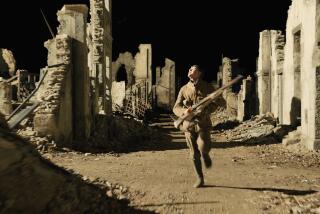A Case for the Warrior Culture : A HISTORY OF WARFARE, <i> By John Keegan (Alfred A. Knopf: $27.50, 432 pp.)</i>
- Share via
Earlier this year the commandant of the Marine Corps suggested that young Marine recruits not be allowed to marry. He was buried under a barrage of ridicule. It was the latest and most outrageous example of clueless military culture, as if Tailhook and the military’s opposition to gays and women had not done enough to damage its public reputation.
We have a President who avoided military service, who declares that the military should reflect the values of the society it defends and who has allied himself with reformers who want to root out the old military culture root and branch. He’s right, up to a point: The majority of our bloated, insular military bureaucracy is little different from the post office, and a lot less efficient. But there is a crucial difference. Postal carriers don’t go to war. Soldiers do, as we were reminded when the coffins came home from Somalia.
The best professional soldiers are frustrated and inarticulate about all this. They love their calling and make great sacrifices to serve it. Many of them believe, deep in their souls, that there are good reasons why gays and women don’t belong in combat, and why it’s dangerous to micro-manage combat units in confused political situations. The problem is, when they try to express those reasons with words like morale and cohesion and tactics they sound insensitive, close-minded and downright dumb. As for the politicians and voters who determine military policy, they know less and less about the military, which hasn’t seemed to produce the slightest humility in their using it.
The beauty of “A History of Warfare” by the distinguished historian John Keegan (author of “The Face of Battle” and “The Mask of Command,” two seminal works on the experience of warfare,) beyond the erudition of its arguments and the sweeping scope of its ideas, is that it presents these dilemmas in the light of thousands of years of history. Keegan finds a disciplined, effective army to be one of the constant features of successful civilizations, a fact that should surprise no one who has watched the deterioration into bestiality in Third World and around the fringes of the Soviet Empire now that the Red Army no longer rules.
He implicitly questions just how much we should civilize our military institutions. Do we want a kinder, gentler, more just military, or a cohesive warrior culture that will fight in an efficient, disciplined way? Do we want to protect the democratic rights of recruits or teach them how to survive in combat? There are those who say these are false choices, but I bet few, if any, of them has actually experienced combat.
Few anthropologists and historians have seen battle, either. For most of them war is the enemy of civilization, a travesty, an affectation, an embarrassment. Not to Keegan. He shows again and again how war and violence is at the heart of every great civilization--including our own. Most historians and anthropologists look at civilizations from the Stone Age to today and ask questions like how does this culture raise its children, feed itself, govern itself and worship its goals? Keegan asks a different question: How does it fight?
At the same time he takes on perhaps the most famous cliche about war, the Clausewitz doctrine that war is politics continued by other means. “War is wholly unlike diplomacy or politics because it must be fought by men whose values and skills are not those of politicians and diplomats. They are those of a world apart, a very ancient world, which exists in parallel with the everyday world but does not belong to it . . . the culture of the warrior can never be that of civilization itself. All civilizations owe their origins to the warrior.”
Keegan takes the reader through the stages of war’s development, organized in sections named after the dominant tools of war in each: stone, flesh, iron and fire, with side trips into fascinating topics such as how to make a composite bow, the development of gunpowder and the smelting of cannon. The tools of war changed it utterly, but Keegan finds ever deeper distinctions in the way the mind, that most powerful of war-making instruments, sees the practice of warfare. He finds two essential warrior cultures, primitive war and Western war.
Primitive war is rooted in nature, which “argued for flight, for cowardice, for self interest.” Western war is based on the “civilized” values of “total obedience, single-minded courage, self-sacrifice, honor.” Beginning with the Greek phalanx, which crashed heedlessly into the enemy seeking a decisive victory, Western war became the organized, hierarchical, killing machine that conquered virtually every inch of the globe at the cost of hundreds of millions of lives and had its final tragic fulfillment in the trench warfare slaughter of World War I and the total warfare of Hitler’s Third Reich.
Primitive war is more stylized and fought with more relish and self-expression. Death was not necessarily its product; in fact, was sensibly to be avoided. This type of warfare consistently was ridiculed by more “civilized” war makers, who were frustrated by the primitive warrior’s unwillingness to concentrate his forces in great groups to be slaughtered--to stand and fight; and by his even greater willingness to flee to fight another day.
Primitive warfare was not always futile against the West, as the Arab revolt, the Little Big Horn and the Zulu victory at Isandlwana, among many others, abundantly illustrate. And, in its Oriental manifestation (best expressed by Clausewitz’s opposite, Sun Tsu), its doctrines of patience, avoidance and wearing down the enemy’s will led to America’s frustration and defeat in Vietnam.
The stylistic warrior culture reached its highest point in Japan, which in the 17th Century outlawed gunpowder and closed its borders to the West. With the supply of fine steel swords limited to the samurai class, the Japanese preserved their distinctive pre-gunpowder warrior culture for another 200 years. When it decided to play on the world stage, Japan then brutally cast the samurai culture aside and became the first non-Western power to master Western warfare.
Keegan makes each new stage of warfare intimate and real, and includes pungent character sketches of great warriors from Genghis Khan to Napoleon. He shows how technology in warfare affected every aspect of society: migration patterns, family life, industrial development and politics--especially politics--since the creation and maintaining of armies became the hallmark of the modern state.
“Armies are an instrument but also a mark of civilization, and without their existence mankind would have to reconcile itself either to life at a primitive level . . . or to a lawless chaos of masses warring, Hobbesian fashion, ‘all against all.’ ” That of course is exactly what we are seeing on television every night in Bosnia, Africa, Armenia and elsewhere.
After 4,000 years, Keegan writes, “warmaking has become a habit.” That habit in primitive times was restrained by ritual and ceremony, but we have today ripped those rituals and ceremonies away and have pushed war-making to its utmost bounds, borrowed the idea of “holy war” from Islam, fed hatred with high technology weapons and pushed war-making into a realm of anarchy and horror.
What is the answer? First, to maintain an effective army, which means preserving the essential elements of the warrior culture--discipline, tradition, morale, cohesion--and to have political leaders who understand how to use it to preserve the order without which no civilization can survive. Otherwise, like King Lear, we will find that the abdication of authority leads to anarchy.
But Keegan proposes more--a rejection of the Clausewitz doctrine of total war and, in this Nuclear Age the relearning of “primitive” approaches to warfare. “The habits of the primitive--restraint, diplomacy, and negotiation--deserve relearning,” Keegan writes, or “we will not survive.”
The sadness is that Keegan undermines his own prescription. In all the examples Keegan cites from four millennia of war, one thing seems clear: Muskets have not given way to arrows, or machine guns to muskets. Men do not fight with rocks and spears when they can use napalm and Stinger missiles. There has been no turning back.
Memo to President Clinton, Secretary of Defense Les Aspin, Congressman Pat Schroeder, and all those without military experience who want to reform the military: Read this book.
More to Read
Sign up for Essential California
The most important California stories and recommendations in your inbox every morning.
You may occasionally receive promotional content from the Los Angeles Times.










